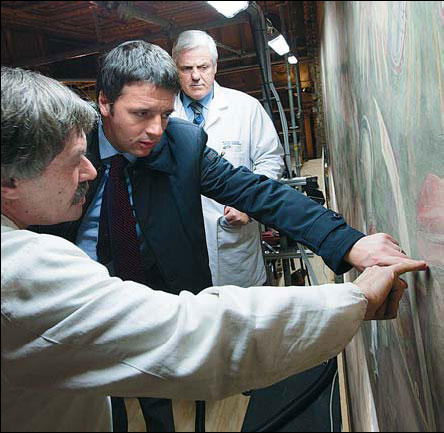Is the 'Lost Leonardo' now found?
Updated: 2012-03-14 10:46
By Philip Pullella in Florence (China Daily)
|
|||||||||||
 |
|
A fresco restorer (left) discusses the work on the Leonardo project with Florence Mayor Matteo Renzi (center), as scientist Maurizio Seracini looks on at the Palazzo Vecchio in Florence. AFP |
Art researchers and scientists said on Monday that a high-tech project using tiny video probes has uncovered evidence that a fresco by Renaissance master Leonardo da Vinci lost for five centuries may still exist behind a wall of Florence's city hall.
"Together with art historians and scientists combining historical evidence and technology, this research team has unlocked a mystery that has been with us for more than 500 years," says Terry Garcia, an executive vice-president of the US National Geographic Society, which sponsored the research.
The project to find what has come to be known as the "Lost Leonardo" has been controversial, in part because researchers had to drill several holes into an existing work and because not all agree that the Leonardo fresco is still there.
At the start of the 16th century, Florence's leaders commissioned Leonardo, then at the height of his career, to paint a massive fresco celebrating the Florentine Republic's victory over the Milanese in a battle on the plains of Anghiari that took place on June 29, 1440.
Leonardo, who loathed war as "a most beastly madness", depicted a group of horses and riders furiously fighting.
He abandoned the project a year after he started, probably because a new experimental technique for frescoes failed. But some of his preparatory studies remain, as well as other artists' copies of the original fresco.
All traces of the original were lost more than 50 years later when Giorgio Vasari renovated the great Sala dei Cinquecento in Florence's Palazzo Vecchio and was ordered to paint a new fresco, The Battle of Marciano, to accommodate the higher walls.
Some believe that Vasari was loathe to destroy Leonardo's work, so he built a new wall with an air gap of several centimeters in front of the Leonardo in order to preserve what was left.
Researchers used tiny, medical-style endoscopic probes and other high-tech tools inserted through existing cracks in the outer wall holding the Vasari fresco and took samples of substances.
"We found traces of pigments that appear to be those known to have been used exclusively by Leonardo," says Maurizio Seracini, an engineer and expert in art diagnostics who has been on the trail of the "Lost Leonardo" for three decades.
"These data are very encouraging," he says, adding that one black pigment found was believed to be of the same type used by Leonardo on the Mona Lisa.
The research work was carried out by the US National Geographic Society, the Center of Interdisciplinary Science for Art, Architecture and Archaeology at the University of California at San Diego and Italian art officials.
"I am quite convinced that something has been found and I think this is a historic day," Garcia says.
"There is overwhelming historic documentation that indicates that the Leonardo was painted, that it was behind the wall and that it was in existence at the time that Vasari painted his fresco," he says.
"Then, through a series of scientific analysis using state-of-the-art imaging technology, we were able to determine that there was a wall in front of the original wall and we confirmed it visually with the endoscope that showed that there is a gap ... and the sample from the wall clearly indicates that there are pigments behind this," he says.
He says it is now up to Italy's culture ministry to decide the next steps and explore other parts of the wall.
"We can't tell you today the condition of the Leonardo. That is for subsequent research and exploration," Garcia says. "Whatever remains of the Leonardo is behind that wall."
But some art historians are sceptical, saying the fresco of Battle of Anghiari was most likely destroyed before Vasari painted his new fresco.
Some art historians working on the project withdrew their support and Italia Nostra, Italy's leading nature and arts conservation group, asked Florentine authorities to halt it because they say it risked harming the Vasari fresco and because they believe it was unlikely that the original Leonardo was there.
Garcia dismisses the criticism. "I think we have demonstrated that those who said the Leonardo was not behind the wall are wrong," he says.
"All of the holes that were put into the mural were either in areas that had been previously restored or in fissures, so the original Vasari was not touched," he says.
But even some of the participants at the presentation urged caution.
"We need further certainties and maximum protection for the Vasari fresco," says Cristina Acidini, arts superintendent for Florence, in response to a question about what the next step would be.
Marco Chatti, head of the Opificio Delle Pietre Dure, Florence's most prestigious arts restoration laboratory, says: "There are pros and cons about every art project."
Florence mayor Matteo Renzi says he believed the Leonardo is behind the wall and that modern technology would allow the public to appreciate both the Leonardo and Vasari.
"But if I had to choose, I would choose Leonardo," Renzi says.
Today's Top News
Rescuers race against time for quake victims
Telecom workers restore links
Coal mine blast kills 18 in Jilin
Intl scholarship puts China on the map
More bird flu patients discharged
Gold loses sheen, but still a safe bet
US 'turns blind eye to human rights'
Telecom workers restore links
Hot Topics
Lunar probe , China growth forecasts, Emission rules get tougher, China seen through 'colored lens', International board,
Editor's Picks

|

|

|

|

|

|





